Easy Lamb Neck Stew
When it comes to hearty meals, few dishes can match the comfort of a well-made stew. This recipe takes inspiration from the classic French beef Bourguignon but swaps in a flavorful and underrated cut of meat. The result is a dish that’s both rich and satisfying.
Using pasture-raised lamb from Shepherd Song Farm ensures the best quality and taste. The slow-cooking process, which takes about three hours, transforms the meat into fork-tender perfection. It’s a one-pot wonder that’s as convenient as it is delicious.
If you can’t find lamb neck, don’t worry. Shoulder or shank works just as well. This recipe also includes a secret thickening technique using kneaded roux, adding depth to the sauce. Pair it with mashed potatoes for a classic comfort food experience the whole family will love.
Introduction to Easy Lamb Neck Stew
Chef Alan Bergo’s restaurant-inspired recipe brings a fresh twist to traditional slow-cooked dishes. Drawing from his experience, this adaptation of a French classic uses grass-fed meat for a rich, flavorful result. The neck cut, often overlooked, shines in this preparation due to its tenderness when cooked slowly.
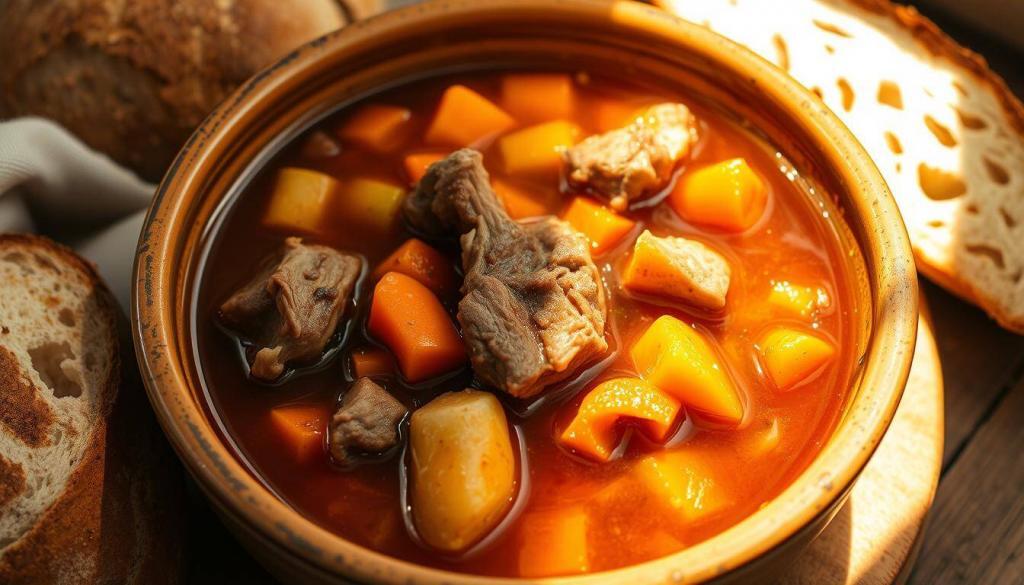
New Zealand lamb is a popular choice for its mild flavor and quality. However, grass-fed options from local farms also work beautifully. Marinating the meat overnight in red wine enhances its depth, while optional garnishes like horseradish sour cream add a tangy finish.
This recipe is highly adaptable. Swap in wild mushrooms or pantry staples based on availability. Each serving packs 54g of protein, making it a nutritious option for any meal. It’s a favorite among both home cooks and professional chefs.
For food safety, always refrigerate the meat during marination. This step ensures the best results while keeping your dish safe to enjoy. Whether you’re new to cooking or a seasoned pro, this recipe is sure to impress.
Ingredients You’ll Need
Quality ingredients are the key to unlocking rich flavors. For this recipe, we recommend starting with 2.5 lbs of lamb neck. If you can’t find this cut, shoulder or shank are excellent alternatives. Each option brings its own unique texture and taste to the dish.
Red wine plays a dual role here. It tenderizes the meat while adding depth to the flavor. Use 1 cup of your favorite variety. For the broth, 2 cups of lamb stock work best. Homemade stock enhances the dish, but store-bought versions are convenient and still deliver great results.
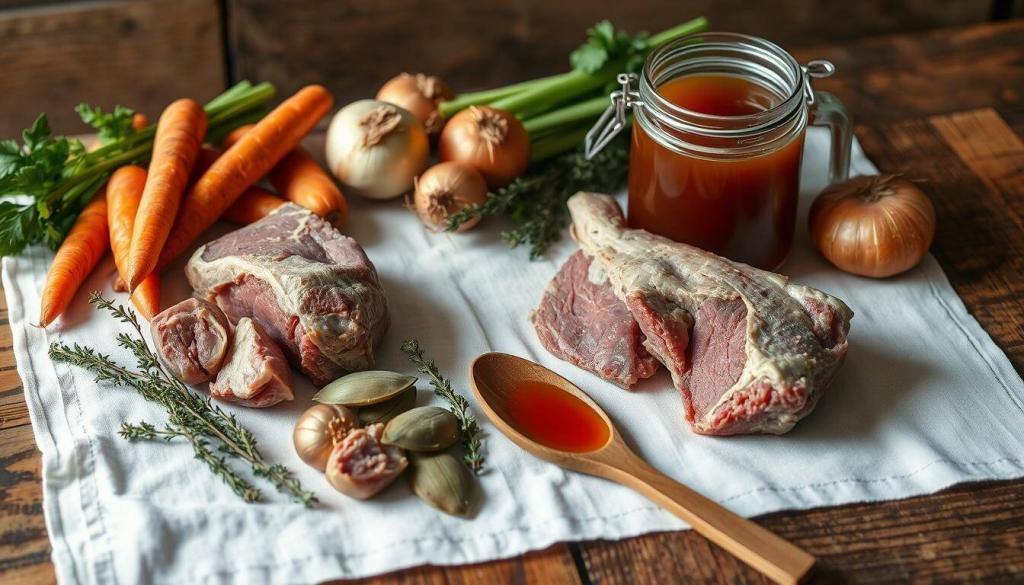
Fresh thyme is a must for this recipe. Its aromatic qualities surpass dried thyme, making it worth the extra effort. If you’re gluten-free, substitute the traditional roux with potato starch flour for thickening. Bacon is a great source of rendered fat, but pancetta or olive oil can be used instead.
For cooking, a Dutch oven or cast iron skillet is ideal. These tools ensure even heat distribution and perfect browning. If you’re using metric measurements, 2.5 lbs equals about 1.1 kg, and 1 cup is approximately 240 ml.
Vegetarian? Swap the meat for a mushroom base. Portobello or shiitake mushrooms create a hearty, flavorful alternative. With these ingredients, you’re ready to craft a dish that’s both satisfying and memorable.
Preparing the Lamb
The secret to a rich and tender meal lies in the preparation. Start by marinating the meat in red wine for up to 24 hours. This step enhances flavor and tenderizes the cut. If you’re short on time, even a few hours will make a difference.
Before cooking, pat the meat dry with paper towels. Removing excess moisture ensures a proper sear. This step is crucial for achieving the Maillard reaction, which creates a deep, caramelized crust.
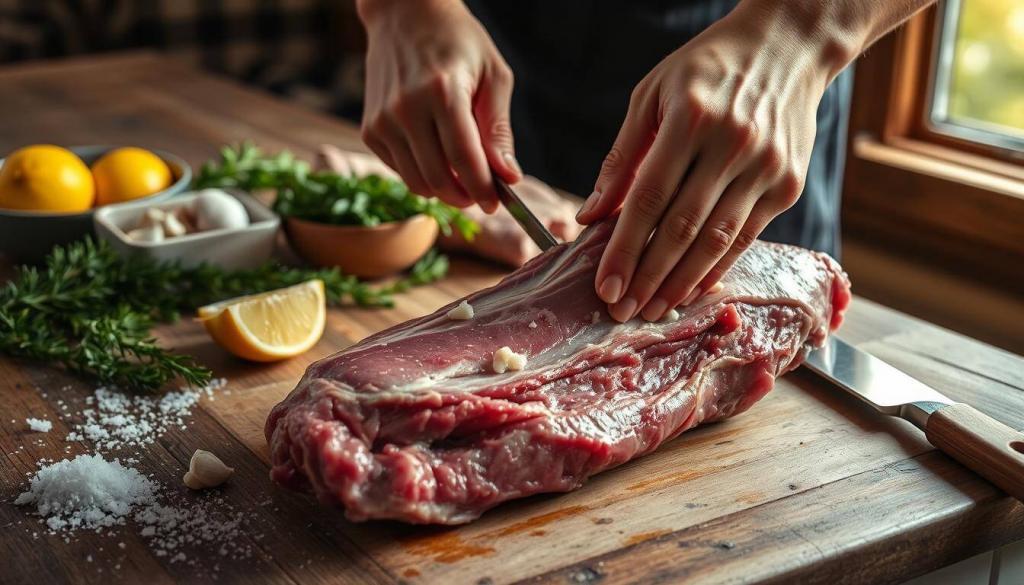
Heat a heavy skillet or Dutch oven over medium-high heat. Add a tablespoon of rendered fat or oil. Working in batches, brown the meat on all sides. Avoid overcrowding the pan to prevent steaming instead of searing.
- Use visual cues to judge doneness. The meat should have a golden-brown crust.
- Save the rendered fat for later stages. It adds depth to the dish.
- If the meat sticks, it’s not ready to flip. Wait until it releases naturally.
For high-heat cooking, consider alternatives like avocado oil or grapeseed oil. These options have a higher smoke point, making them ideal for browning. Once the meat is seared, set it aside and proceed to the next steps.
Building the Stew
Building a flavorful stew starts with layering ingredients for depth. Begin by crisping bacon in a Dutch oven to render its fat. This adds a smoky base to the dish. Next, sauté garlic until fragrant, releasing its aromatic qualities.
Add the braising liquid, combining stock and wine for a balanced flavor. The ratio should be about 2:1, stock to wine. This ensures the stew has enough liquid to simmer without drying out. Set the heat to medium for optimal browning.
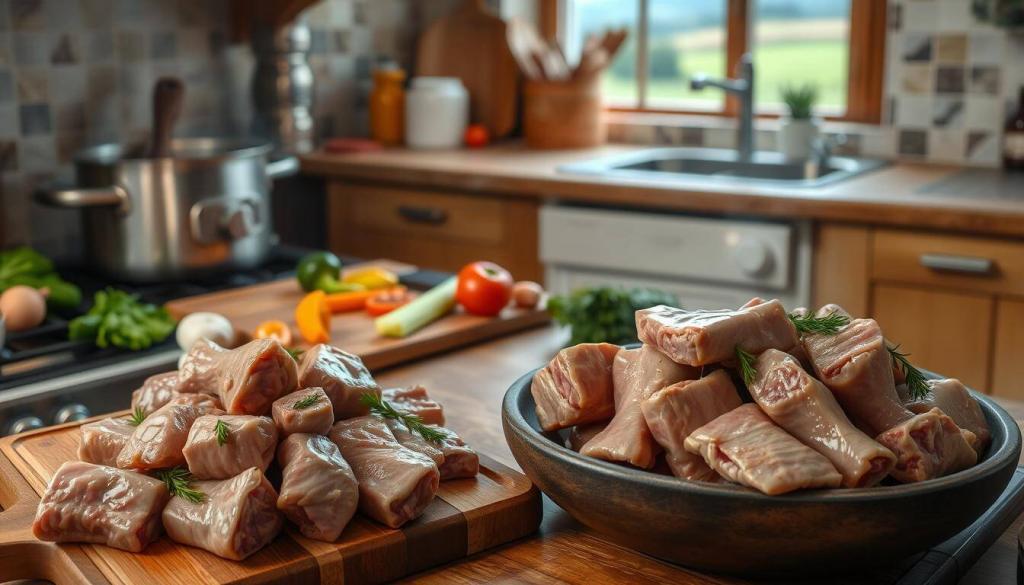
Layer in fresh thyme and bay leaves for added complexity. These herbs infuse the stew with earthy notes. A Dutch oven is ideal for slow cooking, as it retains heat evenly. If using a slow cooker, expect slightly different results due to lower heat intensity.
Cook for several hours at 325°F. This temperature allows the meat to break down enzymatically, becoming fork-tender. To test doneness, gently pull the meat apart with a fork. It should separate easily.
- Monitor liquid levels to prevent evaporation. Add more stock if needed.
- Alcohol evaporates during cooking, making the dish family-friendly.
- Consider adding rosemary or parsley for a fresh finish.
With these steps, you’ll create a stew that’s rich, tender, and full of flavor. The slow cooking process ensures every bite is worth the wait.
Cooking the Vegetables
Adding vegetables to a dish can elevate its flavor and texture significantly. While the meat braises, we have a 20-minute window to prepare the vegetables. This step ensures they cook evenly and retain their natural sweetness.
Start with pearl onions. To peel them easily, blanch them in boiling water for a minute. The skins will slide right off. For mushrooms, choose varieties like cremini or shiitake for their earthy flavor. Honey mushrooms are also a great option if you prefer a milder taste.
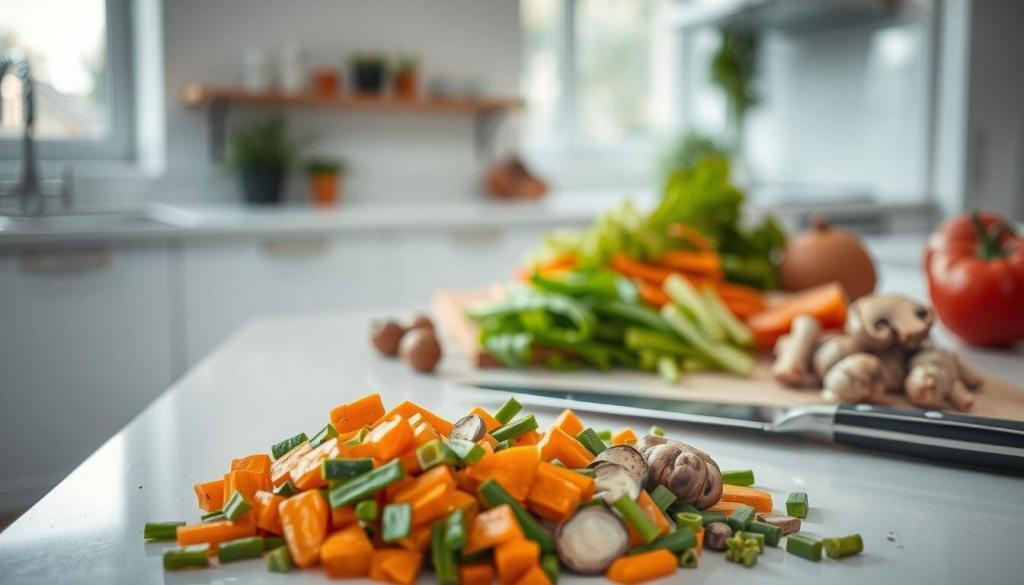
Carrots should be cut into uniform pieces for even cooking. Slice them diagonally to maximize surface area. This allows them to caramelize beautifully. Potatoes are another key ingredient. Choose varieties like Yukon Gold or red potatoes, as they hold their shape well during cooking.
Sequential sautéing builds a flavorful fond. Start with onions, then add carrots, and finish with mushrooms. This method ensures each vegetable cooks perfectly. For a gluten-free roux alternative, use potato starch flour to thicken the sauce.
Overcooking vegetables can make them mushy. To avoid this, add them halfway through the cooking process. Seasonal substitutions like parsnips or turnips can add variety. For a vegan option, replace meat with jackfruit for a similar texture.
| Potato Variety | Best Use | Texture |
|---|---|---|
| Yukon Gold | Stews, Mashed | Creamy |
| Red Potatoes | Roasting, Stews | Firm |
| Russet | Baking, Frying | Fluffy |
Finishing the Stew
Perfecting the final touches on your dish ensures a balanced and flavorful result. One of the key steps is thickening the sauce using a kneaded roux. This technique allows you to control the consistency without clumping.
Start by mixing equal parts flour and fat over low heat. Stir until it forms a smooth paste. Gradually add it to the stew while stirring to avoid lumps. This process, known as starch gelatinization, thickens the sauce evenly.
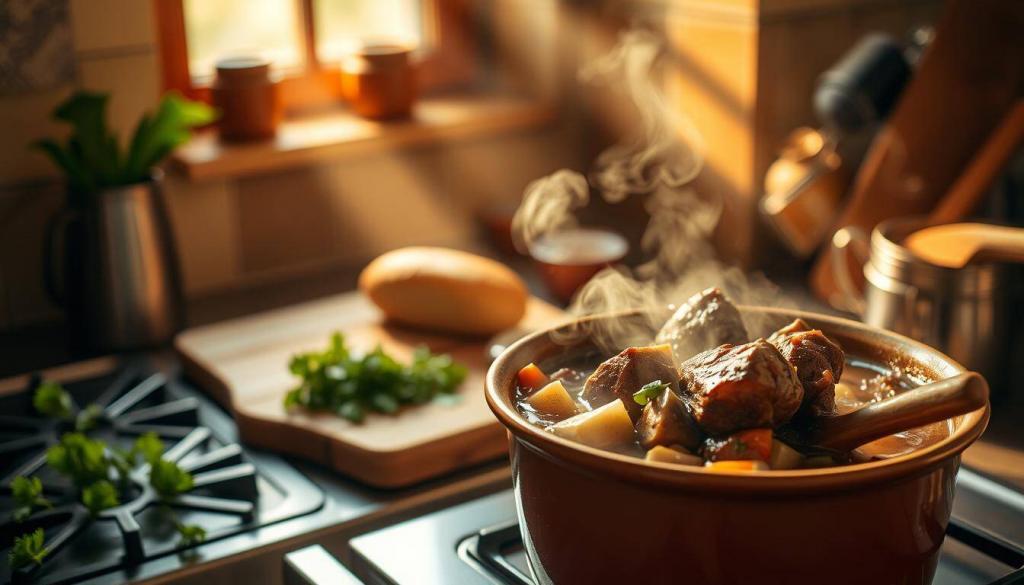
- Skim excess fat from the surface for a healthier presentation.
- Add a splash of wine at the end to balance acidity.
- Test seasoning before serving and adjust if needed.
- If the sauce is too thick, thin it with extra stock.
For make-ahead meals, let the stew cool completely before refrigerating or freezing. When reheating, use low heat to preserve the texture. Simmer gently to bring it back to life.
These finishing steps ensure your dish is rich, flavorful, and ready to impress. Take your time, and enjoy the process of creating something truly special.
Serving Suggestions
Serving a hearty dish like this requires thoughtful presentation and pairing. Each serving contains 1050 calories, making it a satisfying main course. Pair it with creamy mashed potatoes for a classic combination that balances the dish’s richness.
For visual appeal, use wide, shallow bowls to showcase the stew. Garnish with fresh parsley or gremolata for a pop of color and flavor. Bread like crusty sourdough is perfect for soaking up the broth.
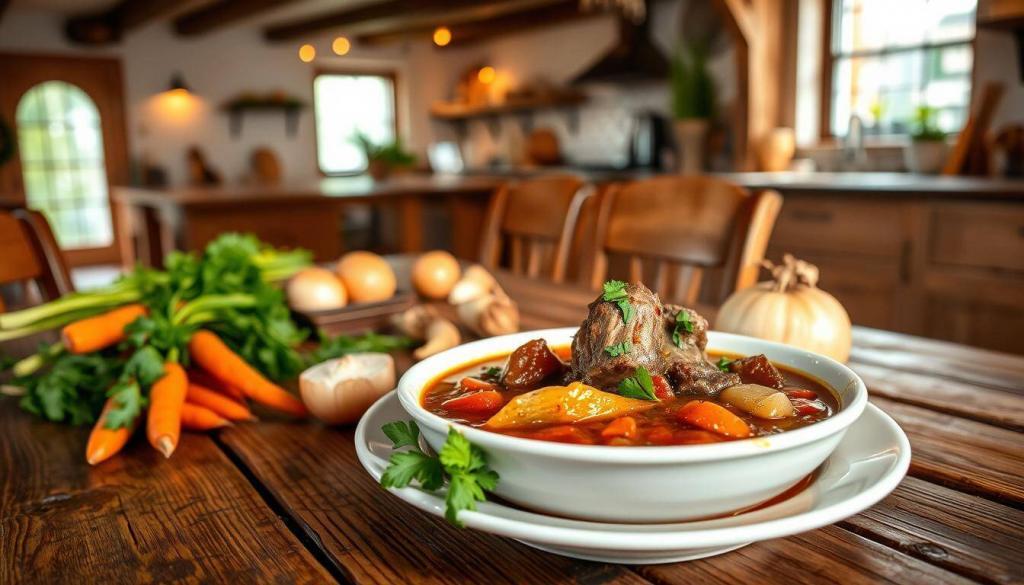
Wine pairing can enhance the meal. A Pinot Noir complements the dish’s depth without overpowering it. For dietary accommodations, consider gluten-free bread or dairy-free mashed potatoes.
| Wine Type | Flavor Profile | Pairing Notes |
|---|---|---|
| Pinot Noir | Light, fruity | Balances richness |
| Cabernet Sauvignon | Bold, tannic | Stronger flavor match |
| Chardonnay | Buttery, oaky | For white wine lovers |
For buffet-style serving, keep the stew warm in a slow cooker. Portion control is key—smaller servings for lighter appetites, larger for heartier eaters. Leftovers can be transformed into a savory pot pie for a new meal.
Cultural traditions offer inspiration too. Moroccan-style serving includes couscous, while Irish traditions favor soda bread. These ideas make the dish versatile and exciting for any occasion.
Additional Tips for the Perfect Stew
Achieving the best results often comes down to small but impactful adjustments. Here are some expert tips to ensure your dish turns out perfectly every time.
Start by sourcing high-quality meat. We recommend Shepherd Song Farm for its pasture-raised options. A good butcher can also guide you to the best cuts for your recipes.
For meal prep, consider freezing marinated meat. This saves time and enhances flavor. If you’re cooking at high altitudes, adjust liquid levels and cooking hours slightly to compensate.
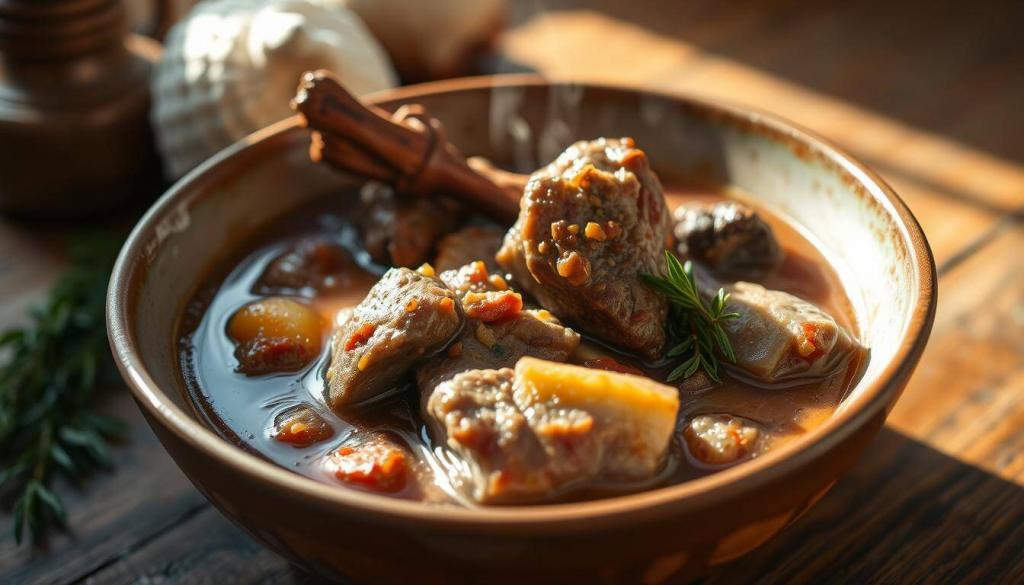
Balancing pH is key. Add a spoonful of tomato paste to brighten the flavor. If you’re out of an ingredient, try substitutions like smoked paprika for pepper or avocado oil for other cooking oils.
Storage matters too. Keep leftovers in the fridge for up to three days or freeze for longer. Fresh herbs make a difference—test their freshness by crushing a leaf to release aroma.
Doubling the recipe for a crowd? Double all ingredients except salt and pepper—add those to taste. Finally, for presentation, use natural light and a clean backdrop for photography.
Enjoy Your Easy Lamb Neck Stew
This dish is a celebration of rich flavors and hearty traditions. From Natasha’s Kitchen, we’ve heard how it brings families together. Feel free to customize the recipe to suit your taste. Swap in different herbs or add root vegetables for a seasonal twist.
Share your creations on social media using #HeartyStew. We’d love to hear your feedback and see your ratings. Stay tuned for more recipes like this, including holiday-inspired dishes perfect for Easter.
Nutritionally, this meal is packed with protein and wholesome ingredients. Using pasture-raised meat supports sustainable farming practices. For an umami boost, try adding a splash of soy sauce or a sprinkle of Parmesan.
Whether it’s a cozy night in or a festive gathering, this recipe is sure to impress. Enjoy every bite and make it your own!
Footer 1
Call the HERD
Always available for any questions. Call and we will be happy to help.
Follow the HERD
Keep up to date on new products available in store.
Important Links
Join the HERD
Be the first to know about any offers or promotions.
- Herd Butchery 2025

Leave a Reply